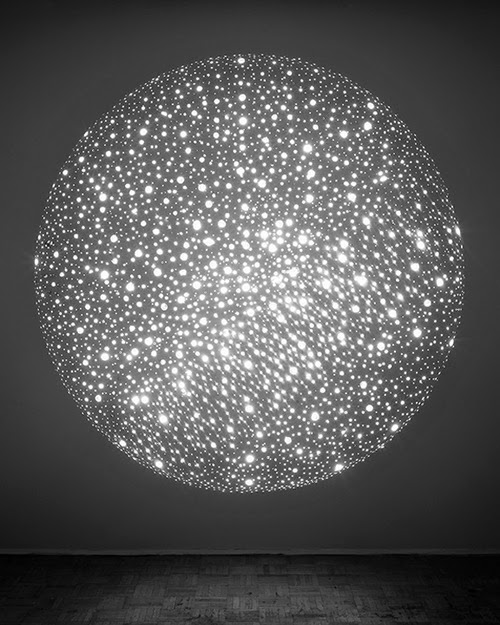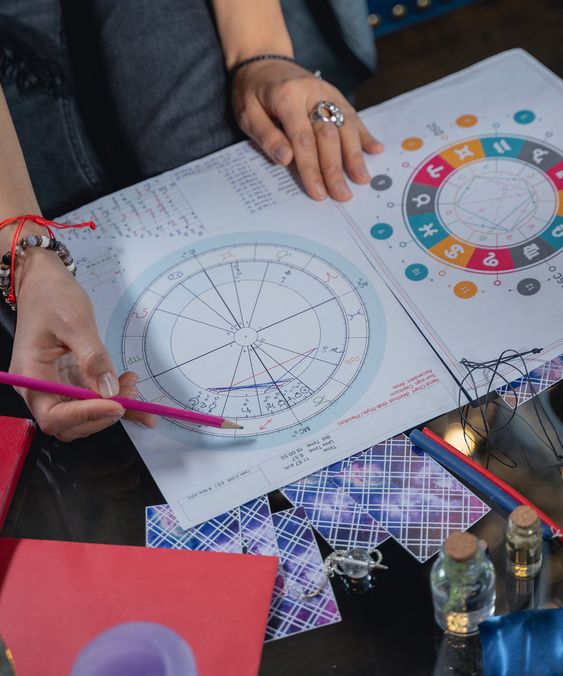
Planets in Signs
 The Greek word for “planet” means “the wanderer,” while “zodiac” literally means “circle of animals.” The planets move through the sky at different speeds as they pass through each of the constellations and zodiac signs. Moving from one zodiacal sign to the next takes a year for the Sun, a month or so for the Moon, and 248 years for Pluto. Your horoscope’s planets provide your birth chart’s “action,” while the signs reveal the planet’s “how” it will manifest itself. The houses reveal “where” specific events in your life will take place, while the signs reveal the costumes that the planets (the actors) will wear. Each of us has a unique perspective on the world and a distinct way of going about our business because of the Planets in the signs under which we were born.
The Greek word for “planet” means “the wanderer,” while “zodiac” literally means “circle of animals.” The planets move through the sky at different speeds as they pass through each of the constellations and zodiac signs. Moving from one zodiacal sign to the next takes a year for the Sun, a month or so for the Moon, and 248 years for Pluto. Your horoscope’s planets provide your birth chart’s “action,” while the signs reveal the planet’s “how” it will manifest itself. The houses reveal “where” specific events in your life will take place, while the signs reveal the costumes that the planets (the actors) will wear. Each of us has a unique perspective on the world and a distinct way of going about our business because of the Planets in the signs under which we were born.
At the core of astrological analysis are the interactions between planets and zodiac signs, which influence the expression of planetary energies.
Here’s a detailed explanation of how astrologers use the positions of planets within signs to interpret their influence:
Planetary Influence and Zodiac Characteristics: Each planet is associated with specific types of energy and areas of life. For example, Mars relates to energy, aggression, and conflict, while Mercury is associated with communication, intellect, and information processing. The zodiac signs, consisting of twelve symbols each with distinct characteristics, modify how these planetary energies manifest. When a planet is positioned in a sign, it colors the planet’s expression with the sign’s traits.
Interaction Between Planets and Signs: The combination of ten planetary bodies and twelve zodiac signs creates a matrix of potential influences. Astrologers believe that a planet in a particular sign adopts some of the sign’s characteristics, shaping the way its energy is expressed. For instance, the fiery and pioneering spirit of Aries influences planets differently than the stable, practical energy of Taurus.
Example: Planets in Aries: Aries, the first sign of the zodiac, is known for its assertive and direct energy. It is associated with qualities like confidence, independence, and enthusiasm for new experiences. Individuals with key planets in Aries are often seen as bold, competitive, and eager to initiate new projects. However, Aries may lack persistence, tending to start things without finishing them.
Specific Case: Venus, the planet that rules over love, beauty, values, and attractions, exhibits different traits when positioned in Aries. Typically, Venus influences what we find attractive and valuable. In Aries, this could translate to a preference for relationships and aesthetics that are bold, direct, and exciting. People with Venus in Aries might be drawn to partners who are assertive and independent, valuing those qualities in themselves as well. They may fall in love quickly, driven by the thrill of new romance, yet their interests might wane just as fast, reflecting Aries’ love for the novel over the familiar.
Personal Astrology: Understanding the impact of a planet’s placement in a sign can offer insights into an individual’s personality traits, tendencies in relationships, and other life areas.
More examples
Planets in Pisces: Pisces is known for its empathy, intuition, and emotional depth. Planets placed in Pisces are expressed in a more varied, adaptable, and selfless manner. The sign’s influence encourages a blending of personal boundaries, leading to a greater capacity for compassion and understanding. For example, Mercury in Pisces might express itself through imaginative, if not somewhat nebulous, communication. Similarly, Mars in Pisces might pursue its goals in a way that is less confrontational and more about aligning with the universal flow.
Planets in Gemini: Gemini, on the other hand, is airy, intellectual, and perpetually curious. This sign’s influence on planets accentuates qualities like verbal fluency, mental agility, and sociability. Gemini’s mutable nature can also bring about a sense of restlessness. A Venus in Gemini might find pleasure in intellectual stimulation and enjoy a social calendar that’s packed with varied interactions. Mars in Gemini could demonstrate a way of asserting itself through intellectual debates or a flurry of multitasking activities.
Distribution of Planetary Energies: Not every sign will be occupied by a planet in a given horoscope, which can create areas of life that are less emphasized compared to others. Conversely, the presence of a stellium, where three or more planets gather in a single sign, marks an area of heightened focus and influence.
Stellium in Capricorn: Capricorn is associated with structure, discipline, and ambition. A stellium in this sign amplifies these qualities, making an individual particularly driven toward achieving status, authority, and recognition in their societal or professional spheres. Such a person may be seen as a natural authority figure, often taking the lead in projects or in the workplace.
Stellium in Scorpio: Scorpio’s influence brings intensity, passion, and a drive for deep transformation. When a stellium occurs in Scorpio, these traits are magnified, leading to an individual who seeks profound changes both personally and in their wider environment. This could manifest as a strong inclination towards crisis management, psychoanalysis, or fields that require a deep understanding of the undercurrents that drive human behavior.
The natal chart, with its varied planetary placements, offers a dynamic portrait of an individual’s potential, challenges, and paths in life. Each planet and sign interaction provides another layer to an individual’s personality and life experiences, illustrating the multifaceted nature of astrology as a tool for self-discovery and understanding.
Even though there is an infinite amount of possible interpretations, this is how astrologers draw their judgments. Planets in signs signify how we respond to our surroundings, how we interpret the world around us, and how we act here on world at large, and we may assess the effect of each sign’s “coloring” on the planet in question.


















 Pluto: The Soul’s Evolution Through Relationships – Jeff Green
Pluto: The Soul’s Evolution Through Relationships – Jeff Green
 Uranus Transits the 6th House
Uranus Transits the 6th House
 Sun Square Pluto Natal Aspect: I Am Titanium
Sun Square Pluto Natal Aspect: I Am Titanium
 Venus Trine Pluto: Dark Desires
Venus Trine Pluto: Dark Desires
 Pluto in the 11th House
Pluto in the 11th House
 Mars Opposite Pluto Natal Aspect: Live Passionately or Burn Silently
Mars Opposite Pluto Natal Aspect: Live Passionately or Burn Silently
 Scorpio’s Cold Withdrawal
Scorpio’s Cold Withdrawal
 Scorpio, 8th House and Pluto – Black Magic & Family Curses
Scorpio, 8th House and Pluto – Black Magic & Family Curses
 Venus Opposite Jupiter: This Doesn’t Describe Me at All!
Venus Opposite Jupiter: This Doesn’t Describe Me at All!
 Transiting Pluto Aspect Natal Mars: Are You Mad as Hell
Transiting Pluto Aspect Natal Mars: Are You Mad as Hell
 Sun Square Pluto Synastry: You’ve Got That Power Over Me
Sun Square Pluto Synastry: You’ve Got That Power Over Me
 Venus Conjunct Pluto: The Love You Can’t Escape
Venus Conjunct Pluto: The Love You Can’t Escape
 Composite Sun in Houses: Part 1
Composite Sun in Houses: Part 1
 Moon Trine Saturn: A Bedrock of Emotional Stability
Moon Trine Saturn: A Bedrock of Emotional Stability
 Venus Trine Neptune: Love, Tenderness, and Empathy Reign
Venus Trine Neptune: Love, Tenderness, and Empathy Reign
 Moon Conjunct Neptune Synastry: Soulmates or Emotional Shipwreck?
Moon Conjunct Neptune Synastry: Soulmates or Emotional Shipwreck?
 Liz Greene: Guide to Astrology Review
Liz Greene: Guide to Astrology Review
 Sun Trine Pluto Natal Aspect: The Quiet Powerhouse
Sun Trine Pluto Natal Aspect: The Quiet Powerhouse
 Moon Conjunct Uranus Natal Aspect
Moon Conjunct Uranus Natal Aspect
 Venus Conjunct Neptune Synastry: Euphoria and the Aftermath
Venus Conjunct Neptune Synastry: Euphoria and the Aftermath